The Fender Stratocaster Turns the Big Five-Oh!
Issue #15
July 13 , 2004
After half a century, this classic still has the looks and sounds that turn heads!
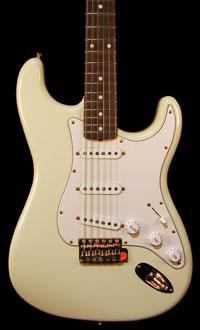 |
| This Custom Shop 1960s reissue looks like
it was brought into the 21st Century via time machine just yesterday.
Note rosewood fretboard. |
It's hard to believe that way back in 1954, Leo Fender - with some help from a small group of close associates like Freddie Tavares and Bill Carson - created a masterpiece that has survived practically unchanged in a world that is well known for its passion for change, for something new and different.
Yet so perfect is the Stratocaster's design that it seems impossible to improve upon it. Over the years, as the Fender company changed owners and management teams, nobody could find a way to make this instrument better, which is a bit surprising when you realize that Leo Fender wasn't even a guitar player.
In 1939, Leo opened up Fender Radio Service, a retail and repair shop in Fullerton, California. How he went from fixing radios to designing what must be considered the most famous - and successful - guitar design of all time could fill a book, and indeed, several have been written on the subject.
Even more surprising is the fact that Leo Fender also designed and built the very first electric fretted bass guitar. Up until that point, bass was produced by huge, unweildy (and difficult to record) acoustic basses, sometimes called double basses or contrabasses. He also invented the world's first solid body electric guitar: What is known today as the Telecaster, but which began life in 1949 as the Broadcaster (the name already belonged to a drum set built by Gretsch, so the name needed to be changed).
THREE PICKUPS, A CONTOURED BODY AND A WHAMMY BAR
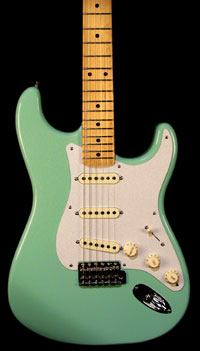 |
| Fairly early in its history, the Stratocaster
became available in solid colors and eventually in custom finishes
like this Sea Foam Green reissue. Note the maple fretboard. |
While the Telecaster quickly became a best seller (and it remains one of the important cornerstones in the Fender guitar line today), Leo listened to the feedback he got from guitarists. They liked the "Tele" but its slab body construction was uncomfortable during all night gigs. What's more, Gibson had introduced its own solid body, dual pickup guitar in about 1953, the Les Paul model.
So Leo went back to the drawing board. He sculpted away part of the guitar's back, where it fit close across a player's ribs, then did some further contouring of the front, right where the guitarist's arm rested when strumming. The Telecaster had a single cutaway for access to the upper frets, so if one cutaway was good, two would be even better! In truth, the first double cutaway instrument was Fender's original electric bass, where wood was abbded to the top "horn" to make the instrument balance better, but so sleek were its lines that Leo used them as a starting point for what would eventually become the best known guitar on the planet.
But he wasn't done yet. Aside from the comfort factor, Leo decided this instrument should go beyond the typical two pickup design. At one point Bill Carson suggested four pickups, but Leo decided that three would do the job nicely and even went so far as to place the bridge pickup at a slight angle to make certain that the bass frequencies were not attenuated. Talk about strokes of genius! What's more, Leo designed his pickups as single coil units, meaning they had a much brighter tone than the relatively darker timbres of the Les Paul.
Slowly the guitar was taking shape, but since this was going to be Leo's masterpiece, he designed a sophisticated tailpiece that not only had six individual bridges (now typically called saddles) that allowed precision intonation, but also allowed all six strings to be bent up or down for pedal steel effects. This came to be known as the Synchronized Tremolo System, though it is actually a vibrato unit, since tremolo refers to changes in volume, while vibrato refers to changes in pitch.
It's worth pointing out that early on, the terms tremolo and vibrato were used interchangeably on both guitars and amplifiers (and not just by Fender). Hey, Leo knew radios, not musical terms, so many original Fender amps had an onboard "vibrato" effect controlled by two knobs, one for speed and the other for intensity, while the Stratocaster had a tremolo. Go figure.
THAT TRADEMARK MAPLE NECK AND HEADSTOCK
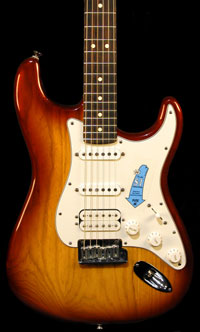 |
| Today, the Strat is available with many options. In this
case, a humbucker has been placed in the bridge position for a
thicker, fatter lead sound. |
Traditional guitars (both flat-top and arch-top acoustics, as well as dobros, steel guitars and so forth) had rosewood fingerboards or sometimes ebony on upscale models, though the necks themselves could be constructed from maple, rosewood or mahogany. Again, Leo bucked the system and his new guitar - like the Tele before it - came standard with a bolt-on "rock maple" neck and integral maple fingerboard. Talk about radical!
Eventually, Fender did introduce rosewood fingerboards as an option, but even today, when you think of Fender guitars, you generally picture one with that trademark blond maple neck and fingerboard.
Even the headstock of the Stratocaster (which we will abbreviate as "Strat" from here on in) was distinctive. The Tele had a rather narrow headstock with "six on a side" tuners, but for the Strat, Leo designed a larger, more curvaceous headstock that allowed for straight string pull across the nut. Today, the Strat headstock is unmistakeable - an elegant and functional design that is immediately recognizable. In fact, while Strats have been copied down to the last detail over the last few decades, using the headstock shape of a Strat would result in immediate legal action.
There is an urban legend that may or may not be true, but it concerns an importer who attempted to bring Strat copies into the U.S. The manufacturer wanted the instrument to look just like a real Stratocaster, right down to the headstock. But when these copies reached our shores, they were not allowed to be offloaded and ended up being shipped back to the manufacturer where the headstocks were cut off and replaced by glued-on "non-Fender" versions. True or not, it makes for an interesting anecdote.
WOODS, CUSTOM COLORS AND "IN BETWEEN" PICKUP SETTINGS
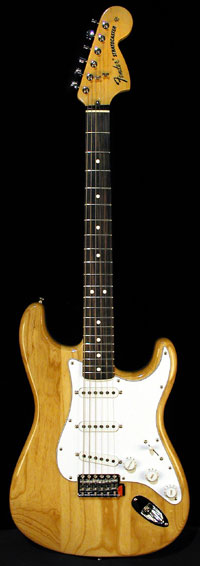 |
| Natural finishes have always been rather rare, but
this 1970s reissue sports some nicely-figured wood. Check out the
large 1970s headstock! |
Once again going "against the grain" (sorry for the wood-based pun), Leo used ash for the guitar bodies rather than the accepted "premium" woods, such as mahogany, maple and spruce. Accounts are sketchy, but most likely the first Strats off the assembly line were finished in a two-toned sunburst: Dark amber and black. Eventually, the company moved to a slightly upscale three-color burst, adding a reddish tint between the black and amber.
As more and more musicians encountered the Strat, each one seemed to develop an affinity for a particular color. Remember that back in the 1950s, auto makers were touting new models with custom colors: reds and blues and even yellow, as opposed to the black, brown or gray automobiles of the 1940s and early 50s.
Taking their cue from this new trend, the Strat eventually became available in custom colors like candy apple red, daphne blue and surf green. To this day, certain high profile Strat players swear that certain color combinations make a difference in the sound, whether it's an Olympic White Strat with a rosewood neck or a bright red Strat preferred by Mark Knopfler ("any color is okay as long as it's red").
Finally, no feature on the Strat would be complete without mention of the fabled "in between" or "out-of-phase" pickup settings. Nobody can say for sure just who came up with this. Initially, Strats came with a three way pickup selector lever. Each of the positions accessed the bridge, middle or neck positions. But someone found that by carefully setting the switch between the first and second position, for example, they got a combination of the neck and middle pickups that had a certain glossy tone that had never been heard before. Once it was heard, everyone wanted it, but it wasn't until 1977 that Fender officially started shipping Strats with five-way pickup switching. Until then, guitar techs who knew their stuff made some big bucks converting those existing three-ways to five-ways.
The bottom line is that Leo's new guitar was light years ahead of its time, yet it still sent shockwaves through an industry that would take many years to play catch up with the looks, sound and feature set.
WHAT'S THE DEAL WITH THE CBS CONNECTION?
A victim of its own success, Fender became a hot commodity by the mid-1960s. Leo had done his job and changed the course of music history and as he had some health problems, decided to sell the company. The highest bidder was CBS - yes, the TV network! And who could turn down a cool $13 million, which in the 1960s was an astronomical amount?
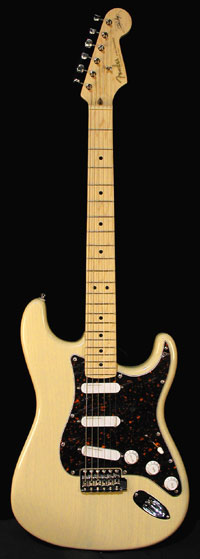 |
| The Buddy Guy Artist Series Strat, shown here in honey blond with tortoiseshell pickguard, comes equipped with an active midrange boost circuit which is accessed via the lower tone control. |
Many believe that CBS-era Fenders have some corporate vibe that make them less desirable, but the truth is that the company continued to turn out excellent instruments for quite some time. I myself once owned a 1973 sunburst Strat with a maple neck that I bought new for about $300. And it was a terrific instrument, despite having the "inferior" three-bolt neck, bullet truss rod and larger headstock (which I still think looks pretty cool).
Unfortunately, by the late 1970s, CBS had begun to tinker just a bit too much with certain design elements and cutting corners in production. Eliminating the recessed jack plate was just one of the bone-headed decisions management made. However, by this time Leo had moved on, and it appeared the company was headed for disaster, so it went up for sale.
Eventually, two decades after CBS purchased Fender, a small group of investors, which included employees and management, purchased the company for $12 million - considerably less in real 1985 dollars than what CBS originally paid.
A RETURN TO GREATNESS
In 1954, there was one guitar: The Strocaster. It could be purchased in sunburst or several optional colors, but that was it. A Strat was a Strat. But today, you might say there is a Strat for every guitar player, regardless of his or her personal preferences. From the basic American Standard Strat to the Custom Shop and Artist Models (Strats that reproduced the features favored by such music legends as Eric Clapton, Jeff Beck, Mark Knopfler, Buddy Guy and others), the company now has dozens of Stratocaster models to choose from.
Like fine wines, vintage automobiles and Sean Connery, the Strat just gets better with age. If anything, the instrument is more popular today than ever before, and part of that popularity stems from the quality instruments the company is producing. Take a look at a few of the photos here for a small sampling.
Despite its age, one thing is certain: The Stratocaster may have been born in the 20th Century, but it's clear that the company has the vision and resources to make this the best selling guitar of the 21st Century.
If you've always wanted to own a bit of the Fender magic, call your Sweetwater Sales Engineer toll-free 800-222-4700!
Questions? Comments? Discuss this article in Jim Miller's Forum
Questions, comments, rants, suggestions, unwanted ‘62
Stratocasters and any other form of correspondence
can be addressed to jim_miller@mindspring.com.
|

